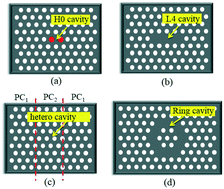Our official English website, www.x-mol.net, welcomes your feedback! (Note: you will need to create a separate account there.)
Applications and developments of on-chip biochemical sensors based on optofluidic photonic crystal cavities
Lab on a Chip ( IF 6.1 ) Pub Date : 2017-10-31 00:00:00 , DOI: 10.1039/c7lc00641a Ya-nan Zhang 1, 2, 3, 4, 5 , Yong Zhao 1, 2, 3, 4, 5 , Tianmin Zhou 1, 2, 3, 4 , Qilu Wu 1, 2, 3, 4
Lab on a Chip ( IF 6.1 ) Pub Date : 2017-10-31 00:00:00 , DOI: 10.1039/c7lc00641a Ya-nan Zhang 1, 2, 3, 4, 5 , Yong Zhao 1, 2, 3, 4, 5 , Tianmin Zhou 1, 2, 3, 4 , Qilu Wu 1, 2, 3, 4
Affiliation

|
Photonic crystal (PC) cavities, which possess the advantages of compactness, flexible design, and suitability for integration in a lab-on-a-chip system, are able to distinguish slight variations in refractive index with only a small amount of analyte. Combined with the newly proposed optofluidic technology, PC-cavity devices stimulate an emerging class of miniaturized and label-free biochemical sensors. In this review, an overview of optofluidic PC cavities based biochemical sensors is presented. First, the basic properties of the PC, as well as the sensing principle of the PC cavity, are discussed. Second, the applications of the sensors in detecting gas, liquid, and biomolecule concentrations are reviewed, with a focus on their structures, sensing principles, sensing properties, advantages, and disadvantages. Finally, the current challenges and future development directions of optofluidic PC-cavity-based biochemical sensors are discussed.
中文翻译:

基于光流体光子晶体腔的片上生化传感器的应用与发展
光子晶体(PC)腔体具有紧凑,灵活的设计以及适合集成在芯片实验室系统中的优点,能够仅用少量分析物就能分辨出折射率的微小变化。结合最新提出的光流技术,PC腔设备刺激了新兴的一类小型化且无标签的生化传感器。在这篇综述中,将介绍基于光流体PC腔的生化传感器的概述。首先,讨论了PC的基本特性以及PC腔的传感原理。其次,回顾了传感器在检测气体,液体和生物分子浓度中的应用,重点是传感器的结构,传感原理,传感特性,优缺点。最后,
更新日期:2017-10-31
中文翻译:

基于光流体光子晶体腔的片上生化传感器的应用与发展
光子晶体(PC)腔体具有紧凑,灵活的设计以及适合集成在芯片实验室系统中的优点,能够仅用少量分析物就能分辨出折射率的微小变化。结合最新提出的光流技术,PC腔设备刺激了新兴的一类小型化且无标签的生化传感器。在这篇综述中,将介绍基于光流体PC腔的生化传感器的概述。首先,讨论了PC的基本特性以及PC腔的传感原理。其次,回顾了传感器在检测气体,液体和生物分子浓度中的应用,重点是传感器的结构,传感原理,传感特性,优缺点。最后,


























 京公网安备 11010802027423号
京公网安备 11010802027423号